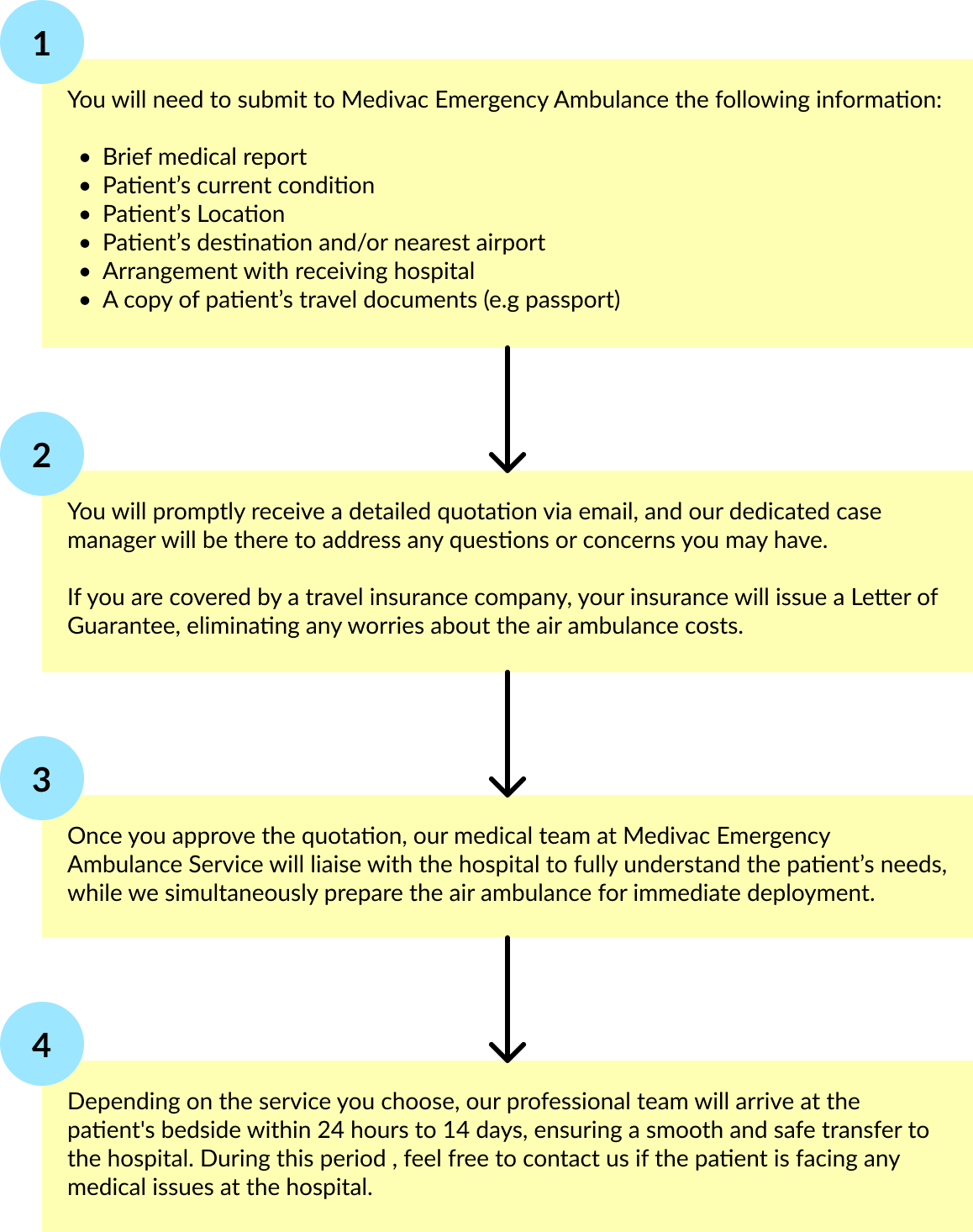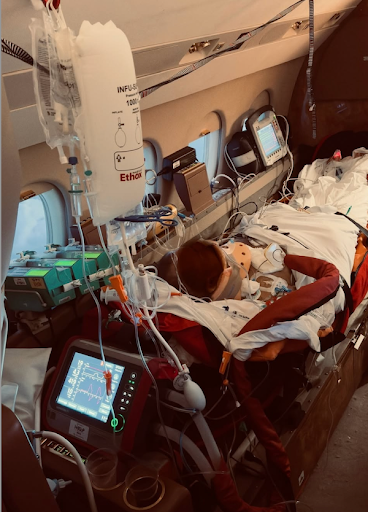What is the procedure of getting an Air Ambulance ?

Air Ambulance or Medical Evacuation Cost in Singapore ?
At Medivac Emergency Ambulance Service, we recognize that every call represents a family in need of assistance. That’s why our operators are trained by our doctors to follow established protocols and advise the next of kin on the best mode of transportation for the patient.
Commercial airlines offer a cost-effective way to transport patients back to their home country, but the patient must be medically stable and certified fit for flight by both the attending physician and our aviation doctor.
Additionally, at Medivac Emergency Ambulance Service, we can arrange to apply for MEDIF for patients who require oxygen support or need mechanical ventilation while on board the airline.
| Commercial Flight | Private Air Ambulance | |
| Lead Time | 4 – 14 days | 24 hours |
| Use of Oxygen on board plane | ✅ | ✅ |
| Use of mechanical ventilator on plane |
✅ stable patients only |
✅ |
| Lying down on plane | ✅ | ✅ |
| Tarmac Access | ✅ | ✅ |
| Patient Monitoring on board plane | ✅ | ✅ |
| ECMO / IABP support on plane | ❌ | ✅ |
What is the cost of bringing a patient back on board a commercial airline?
Medical evacuation through commercial airlines offers a cost-effective solution for both insurance companies and individuals paying out of pocket.
When considering the expenses of medical evacuation, it’s important to note that prices vary depending on the flight and the specific medical requirements of the patient.
For patients who can sit upright and handle their own needs, such as using the restroom without assistance, clients typically only need to buy 1 to 2 seats. However, for those requiring additional support, such as a stretcher or assistance with medical equipment, purchasing 8 or more seats may be necessary to accommodate the stretcher and oxygen tanks.
For medical evacuation via commercial airlines , you can contact us at + 65 6100 6910
Some cases handled by Medivac Emergency Ambulance Services and the medical evacuation cost include:
Medical Evacuation from KTPH , Singapore to Meenakshi Hospital , India
The patient suffered a stroke in Singapore, and his condition was stabilized. He was placed on oxygen support and IV infusion at 2 LPM.
Both the employer and the patient’s family wished for him to continue his rehabilitation at Meenakshi Hospital in India. Medivac Emergency Ambulance Service collaborated with Air India and successfully transported the patient to Meenakshi Hospital within 72 hours of confirmation.
During the flight, the patient was able to sit upright and required two seats. A Flight Nurse, equipped with emergency medications, accompanied him on board.
The total cost of medical evacuation using a commercial air ambulance from Singapore to India using a commercial airline was USD 11,900.
Medical Evacuation from NTUH , Taiwan to KPJ Johor Specialist Hospital , Malaysia
What was meant to be a joyful family outing took a tragic turn when a patient unexpectedly suffered a stroke and became unconscious. After three weeks of intensive treatment without any signs of recovery, the family made the difficult decision to seek a second opinion in their home country.
A medical team, consisting of a doctor and a flight paramedic, escorted the patient using Malaysia Airlines. The patient was on a life support machine and required mechanical ventilation.
The total cost for the medical evacuation, which involved using a commercial airline with an onboard stretcher, oxygen, and a mechanical ventilator, amounted to USD $33,000.
How soon after having a stroke can a person fly?
The American Heart Association (AHA) recommends that individuals wait until they are stable and have fully recovered before traveling.
At Medivac Emergency Ambulance Service, we advise patients to seek medical attention at a local hospital first, unless that hospital lacks the necessary facilities for their treatment. Evacuating an unstable patient carries certain risks.
When accompanied by medical professionals on board a commercial aircraft, a patient who has had a stroke can fly 2 weeks after the event, or just 5 days after a Transient Ischemic Attack (TIA).
Medical evacuation guidelines for flying via Commercial airlines.
However as a general guidelines , the following medical conditions are usually not accepted by most commercial airlines :
- Severe cases of anaemia
- Severe cases of either middle ear infections (otitis media) or sinusitis
- Acute, contagious or communicable diseases
- Those suffering from congestive cardiac failure or other cyanotic conditions which aren’t fully controlled
- Uncomplicated myocardial infarctions (MI) within two weeks of onset, or complicated MIs within six weeks of onset
- Those suffering from severe respiratory diseases or recent pneumothorax
- Those with gastrointestinal lesions which may cause hematemesis, melaena or intestinal obstruction
- Post‑operative cases:
- Within 10 days of simple abdominal operations
- Within 21 days of chest or invasive eye surgery (not including laser surgery)
- Jaw or jawbone fractures with fixed wiring of the jaw (unless medically escorted)
- Unstable mental illnesses without escort and suitable medication for the journey
- Uncontrolled seizures (unless medically escorted)
- Uncomplicated single pregnancies beyond the end of the 36th week or multiple pregnancies beyond end of the 32nd week
- Infants within seven days of birth
- Those who have introduced air to body cavities for diagnostic or therapeutic purposes within the previous seven days
- Terminally ill patients (unless medically escorted)
For medical evacuation via commercial airlines , you can contact us at + 65 6100 6910
What is the qualification / training of your flight medical crew ?
Flight Doctor
- Emergency medicine specialist with 3 years experience; or
- Registered Medical Practitioner with at least 5 years of experience in critical and/or emergency care; and
- Advanced Cardiac Life Support (ACLS) ; and
- Paediatric Advanced Life Support (PALS); and
- Advanced Trauma Life Support
Flight Nurse or Paramedic
- Registered with Singapore Nursing Board or UPEC for paramedics
- At least 3 years of emergency and critical care experience
- Valid BCLS certification
- Trained in ACLS , PHTLS and PALS
- Fundamental Critical Care Life Support Course (FCCS) or BASICS Mechanical ventilation course
- Successfully Completed Aviation Medical Assistant (MA) Course

